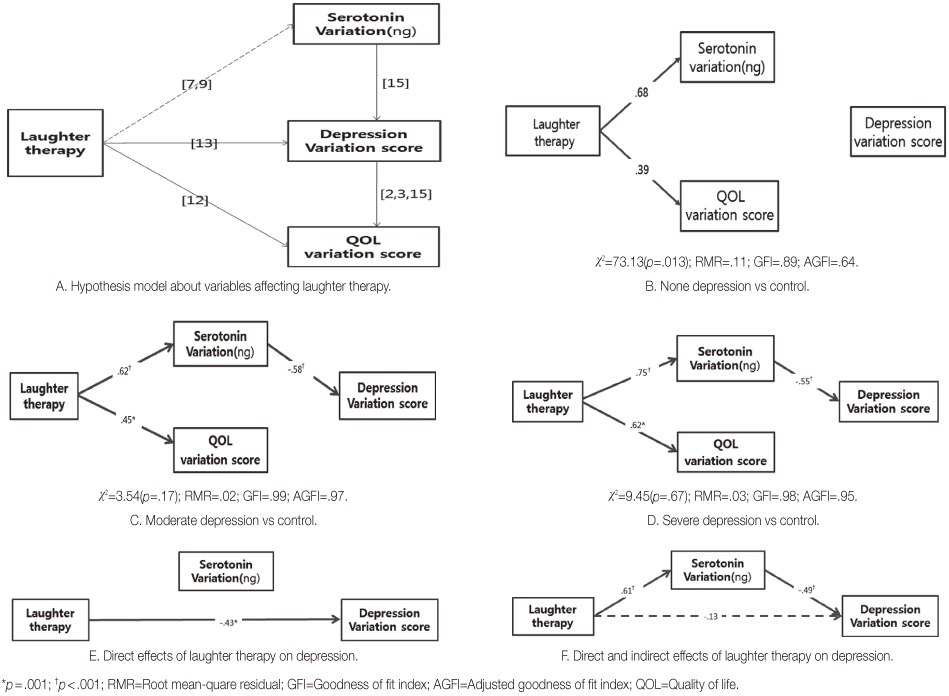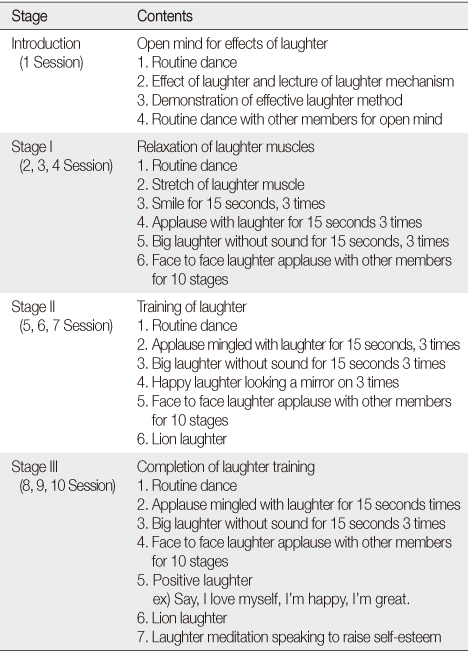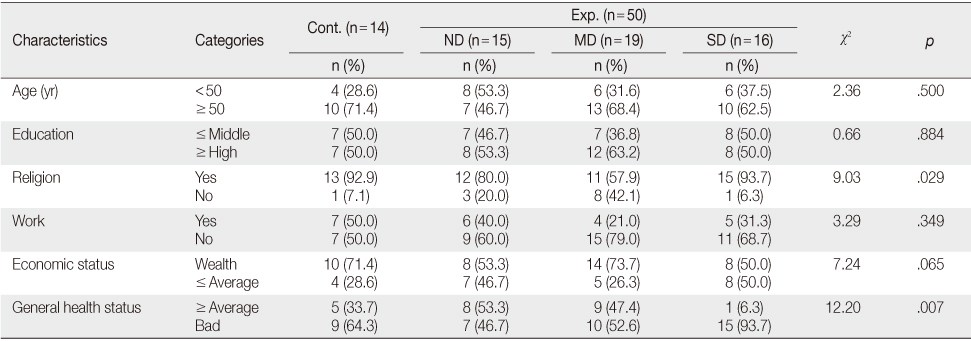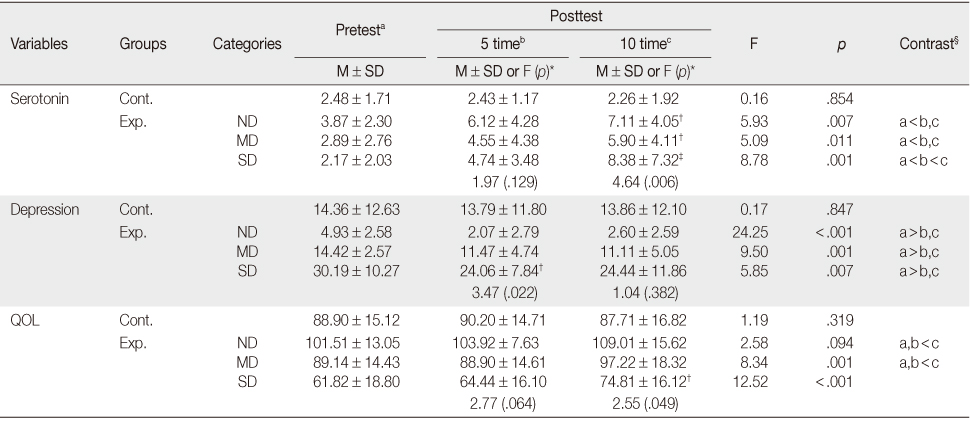Articles
- Page Path
- HOME > J Korean Acad Nurs > Volume 45(2); 2015 > Article
-
Original Article
- Effect and Path Analysis of Laughter Therapy on Serotonin, Depression and Quality of Life in Middle-aged Women
- Mi Youn Cha, Hae Sook Hong
-
Journal of Korean Academy of Nursing 2015;45(2):221-230.
DOI: https://doi.org/10.4040/jkan.2015.45.2.221
Published online: April 30, 2015
1Department of Nursing, Uiduk University, Pohang, Korea.
2College of Nursing, Kyungpook National University, Daegu, Korea.
- Address reprint requests to: Hong, Hae Sook. College of Nursing, Kyungpook National University, 680 Gukchaebosang-ro, Jung-gu, Daegu 700-422, Korea. Tel: +82-53-420-4932, Fax: +82-53-421-2758, hshong@knu.ac.kr
© 2015 Korean Society of Nursing Science
This is an Open Access article distributed under the terms of the Creative Commons Attribution NoDerivs License. (http://creativecommons.org/licenses/by-nd/4.0/) If the original work is properly cited and retained without any modification or reproduction, it can be used and re-distributed in any format and medium.
Figure & Data
REFERENCES
Citations

- Effectiveness of yoga and laughter yoga in improving psychological resilience of mothers with babies hospitalized in neonatal intensive care unit
Zerrin Çiğdem, Emine Sarikamiş Kale, Tuba Koç Özkan
Journal of Health Psychology.2025; 30(8): 1915. CrossRef - The Effects of Comedy Movies on Preoperative Anxiety and Postoperative Pain in Patients Who Have Undergone Abdominal Surgery: A Pilot Randomized Controlled Trial
Gürkan Kapıkıran, Semra Bülbüloğlu, Remziye Cici
Nursing & Health Sciences.2025;[Epub] CrossRef - Laughter Interventions to Improve Psychological Well-Being/QoL in Cancer Patients: A Mini Systematic Review
Anastasia Olympiou, Sana Ahmed
Sage Open.2024;[Epub] CrossRef - Development of an Artificial Intelligence–Based Tailored Mobile Intervention for Nurse Burnout: Single-Arm Trial
Aram Cho, Chiyoung Cha, Gumhee Baek
Journal of Medical Internet Research.2024; 26: e54029. CrossRef - Laughter: A signal of ceased alarm toward a perceived incongruity between life and stiffness
Carlo V. Bellieni
New Ideas in Psychology.2023; 68: 100977. CrossRef - Effects of laughter therapy on the stress response of married immigrant women in South Korea: A randomized controlled trial
Yejung Ko, Eun-suk Lee, Sihyun Park
Health Care for Women International.2022; 43(5): 518. CrossRef - The Effect of Laughter Therapy on Physical and Mental Health: Systematic Review
Elif ÜNER, Ayşe SEZER BALCI, Hasibe KADIOĞLU
Halk Sağlığı Hemşireliği Dergisi.2022; 4(3): 251. CrossRef - Effectiveness of Whole-Body Vibration Training to Improve Muscle Strength and Physical Performance in Older Adults: Prospective, Single-Blinded, Randomized Controlled Trial
Nam-Gyu Jo, Seung-Rok Kang, Myoung-Hwan Ko, Ju-Yul Yoon, Hye-Seong Kim, Kap-Soo Han, Gi-Wook Kim
Healthcare.2021; 9(6): 652. CrossRef - Humor and A1C: the interaction between humor and diabetes control
David S. Greene, Nancy Dunavant King
HUMOR.2021; 34(4): 483. CrossRef - Depressive Symptoms are Associated with low Serotonin Levels in Plasma but are not 5–HTTLPR Genotype Dependent in Older Adults
Pedro Enrique Trujillo-Hernández, Aide Sáenz-Galindo, Odila Saucedo-Cárdenas, María de los Ángeles Villarreal-Reyna, Mauricio Andrés Salinas-Santander, Ana Laura Carrillo-Cervantes, Reyna Torres-Obregón, Sandra Cecilia Esparza-González
The Spanish Journal of Psychology.2021;[Epub] CrossRef - GELENEKSEL VE TAMAMLAYICI TIP UYGULAMALARININ GÜLEN YÜZÜ: KAHKAHA YOGASI
Zülfünaz ÖZER, Sebahat AKBAL ATEŞ
Journal of Anatolia Nursing and Health Sciences.2021;[Epub] CrossRef - Effectiveness of progressive muscle relaxation and laughter therapy on mental health and treatment outcomes in women undergoing in vitro fertilization: A randomized controlled trial
Sibel Kiyak, Deniz Kocoglu‐Tanyer
Research in Nursing & Health.2021; 44(6): 945. CrossRef - Diabetes and Humor: A Preliminary Investigation
David S. Greene, Nancy Dunavant King, Jean Bryan Coe
Diabetes Spectrum.2020; 33(2): 175. CrossRef - Effects of a laughter programme with entrainment music on stress, depression, and health-related quality of life among gynaecological cancer patients
Yong Jin Lee, Myung Ah Kim, Hye-Ja Park
Complementary Therapies in Clinical Practice.2020; 39: 101118. CrossRef - The effects of watching comedy videos on anxiety and vital signs in surgical oncology patients
Hasan Genç, Serdar Saritas
EXPLORE.2020; 16(6): 401. CrossRef - Incongruent Expression of Brain-Derived Neurotrophic Factor and Cortisol in Schizophrenia: Results from a Randomized Controlled Trial of Laughter Intervention
Shu-Li Cheng, Fu-Chi Yang, Hsuan-Te Chu, Chia-Kuang Tsai, Shih-Chieh Ku, Yu-Ting Tseng, Ta-Chuan Yeh, Chih-Sung Liang
Psychiatry Investigation.2020; 17(12): 1191. CrossRef - Beneficial effect of laughter therapy on physiological and psychological function in elders
Yuki Yoshikawa, Etsuko Ohmaki, Hirohisa Kawahata, Yoshihiro Maekawa, Toshio Ogihara, Ryuichi Morishita, Motokuni Aoki
Nursing Open.2019; 6(1): 93. CrossRef - The Effect of Comedy Films on Postoperative Pain and Anxiety in Surgical Oncology Patients
Serdar Sarıtaş, Hasan Genç, Şerafettin Okutan, Ramazan İnci, Ahmet Özdemir, Gülnaz Kizilkaya
Complementary Medicine Research.2019; 26(4): 231. CrossRef - EFFECT OF LAUGHTER THERAPY ON DEPRESSION LEVEL IN ELDERLY IN A NURSING HOME, NORTH SUMATRA, INDONESIA
Rinco Siregar, Rumondang Gultom
Belitung Nursing Journal.2019; 5(6): 246. CrossRef - The effect of laughter therapy on the quality of life of nursing home residents
Nilgun Kuru, Gulumser Kublay
Journal of Clinical Nursing.2017; 26(21-22): 3354. CrossRef - Physical Activity, Yoga and their Psychological Effects
Karel Nespor
Cognitive Remediation Journal.2017; 6(1): 24. CrossRef - Effects of Laughter Therapy on Depression and Sleep among Patients at Long-term Care Hospitals
Ji Hyoung Han, Kyung Min Park, Heeok Park
Korean Journal of Adult Nursing.2017; 29(5): 560. CrossRef - Fyzická aktivita a jóga: jejich působení na psychiku
Karel Nešpor
Cognitive Remediation Journal.2017; 6(1): 16. CrossRef - A Systematic Review of Non-pharmacological Intervention for Depression in Korean Middle-aged Women
Myung-Ock Chae, Hae Ok Jeon, Ahrin Kim
Journal of the Korea Academia-Industrial cooperation Society.2016; 17(3): 638. CrossRef - Yoga and physical exercise – a review and comparison
Ramajayam Govindaraj, Sneha Karmani, Shivarama Varambally, B.N. Gangadhar
International Review of Psychiatry.2016; 28(3): 242. CrossRef - Therapeutic Benefits of Laughter in Mental Health: A Theoretical Review
JongEun Yim
The Tohoku Journal of Experimental Medicine.2016; 239(3): 243. CrossRef - Effects of Laughter Therapy on Immune Responses in Postpartum Women
Kyung Hee Ryu, Hye Sook Shin, Eun Young Yang
The Journal of Alternative and Complementary Medicine.2015; 21(12): 781. CrossRef

Figure 1
Contents of Laughter Therapy Program
Homogeneity Test of General Characteristics (N=64)
Cont.=Control group; Exp.=Experimental group; ND=None depression; MD=Moderate depression; SD=Severe depression.
Pre-score of Serotonin and QOL of Subjects (N=64)
Cont.=Control group; Exp.=Experimental group; ND=None depression; MD=Moderate depression; SD=Severe depression; QOL=Quality of life.
Effect of Laughter Therapy on Serotonin, Depression and QOL within Group (N=64)
*ANCOVA adjusted for pre score; †p<.05; ‡p<.01; §Contrast; Repeated Measures ANOVA of variance of contrast variables. Index 1,2 and 3 Inicate to 1: pre-test, 2: post-test after 5 times, and 3: post-test after 10 times; Cont.=Control group (n=14); Exp.=Experimental group (n=50); ND=None depression (n=15); MD=Moderate depression (n=19); SD=Severe depression (n=16); QOL=Quality of life.
Cont.=Control group; Exp.=Experimental group; ND=None depression; MD=Moderate depression; SD=Severe depression.
Cont.=Control group; Exp.=Experimental group; ND=None depression; MD=Moderate depression; SD=Severe depression; QOL=Quality of life.
*ANCOVA adjusted for pre score; †
 KSNS
KSNS
 E-SUBMISSION
E-SUBMISSION





 Cite
Cite

